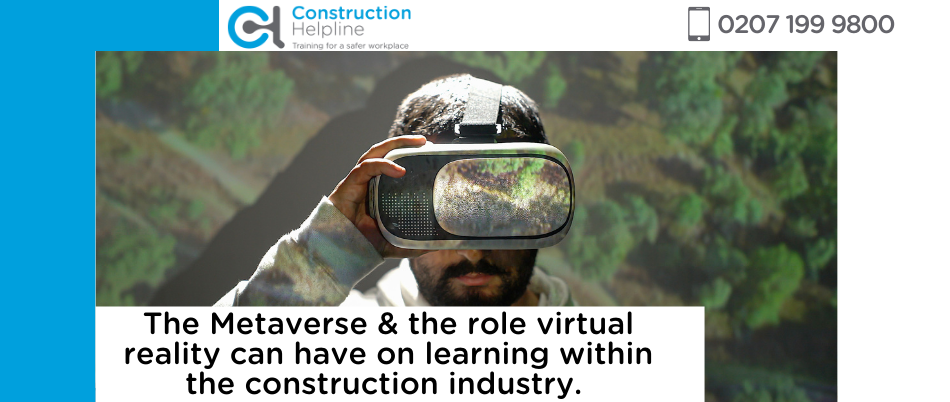The Metaverse & the role virtual reality can have on learning within the construction industry
The buzzword ‘metaverse’ has become increasingly popular since Facebook’s 2021 rebranding, moving away from just being a standard social media company into “a metaverse company”, but what does that actually mean? With major corporations such as Disney, JPMorgan and Microsoft already actively preparing metaverse strategies for the near future, there is no doubt that eventually the construction industry will find their place within this virtual space. This article will be discussing what exactly the metaverse and virtual reality is, along with how some aspects have already been implemented within the sector and the implications it has on construction learning.
What is the metaverse?
In its simplest form, the metaverse can be described as a more responsive and inclusive version of virtual experiences, where you can create and explore with people not in the same physical space as you. Some have even called it to be ‘the internet of the future’. In October 2021, when Facebook CEO Mark Zuckerberg revealed to the world that the new parent company of Facebook, Meta, would be shifting its focus into building the metaverse in hopes to produce an ‘embodied internet’ that blends both the real and virtual world in a way that we have never seen before.
Some of the properties that make up what the metaverse actually is include being massively scaled, an unlimited number of users, an individual sense of presence and 3D virtual worlds that are rendered in real time. The metaverse can be seen as an amalgamation of virtual reality, augmented reality and 3D digital worlds.
What is virtual reality?
Although virtual reality is part of the metaverse, it is more than just a ‘3D virtual world’. Virtual reality is a simulated environment in which an interactive computer-generated user experience can take place. It is essentially a computer generated simulation of the real world where the viewer is able to both view and manipulate the contents of the environment around them. VR comes in two forms:
- Desktop VR = virtual reality that is PC based. The user interacts and views computer represented imagery on a traditional computer screen
- Immersive VR = users use a head mounted display, also known as VR headsets, instead of a screen. These headsets make the user feel as if they are actually in the environment they are seeing as it completely surrounds the viewer. Unlike desktop VR, immersive VR uses hardware and software that is more sophisticated (for example, it can require super computers, power gloves and position tracking devices).
Even though VR is currently commonly associated with entertainment, some construction companies have already found use for the technology.
How it has been used so far in the construction sector?
Applications of virtual reality can be done in both the development phases of design, including interior design and fire risk assessment, and construction phases of a project, including site planning and evaluation of construction scenarios. CADs and BIM are two processes that utilise VR.
Computer Aided Design (CAD) is a software used by engineers and architects to create designs of precise drawings and illustrations of new builds, with plans being either two or three dimensional. Architects can then use this data from CADs and turn it into interactive VR experiences for contractors and investors to see what the completed project will look like.
Building Information Modelling (BIM) is the process of planning, designing and managing all information about the project during the lifecycle of the build. It is essentially a 3D digital-description of the project being built. BIM allows project managers and subtractors to place complex information into these models which allows them to view designs in great detail from every possible angle. With more research and development into the Metaverse over the coming years, the implementation of VR will play a pivotal role in construction entering this new space.
What can the future of construction training look like with VR?
The potential of construction training within the metaverse using VR can change the way the industry educates workers forever. With candidates training in simulated workspaces when learning the health and safety guidelines, they will be able to explore and gain familiarity by practising in simulated environments where knowledge and skills can be acquired without any real-world consequences. This will provide a safer and more effective training for construction workers while also being less expensive to train, especially when it comes down to heavy-equipment such as crane operations.
Many engineering graduates receive diplomas without sufficient practice or training in terms of how to work on-site. Therefore, if in the near future organisations like the CSCS implement VR training into their scheme, students wanting to enter the building industry will be able to receive that much needed experience before graduation. VR construction training will also allow candidates to train anytime and at any location, giving the learner the convenience to learn virtually whenever it suits them best.
Summary
Although the development of construction-related strategies is in the very early stages of utilising the metaverse, there is no doubt in the potential it holds in terms of digitising construction. Virtual reality may be the technology needed to abolish the traditional division that exists between the design phase and construction phase of a project, while also educating the next generation of construction professionals in the industry.


